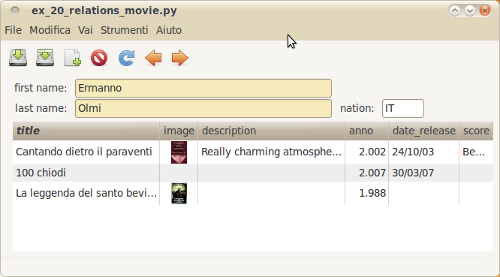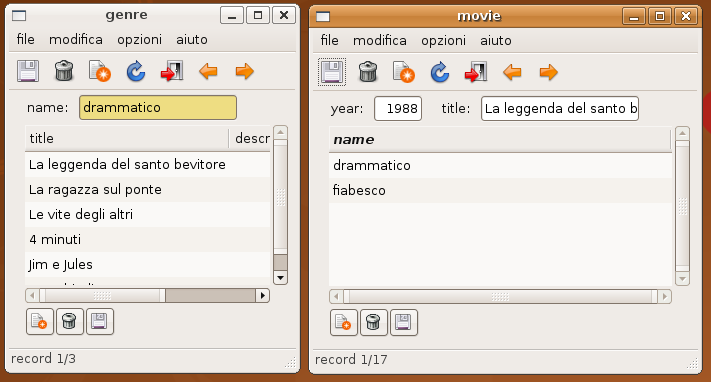Relationships¶
Sqlkit makes editing of data that have relation as one2many or many2many very simple. It’s as easy as adding a field in the layout of the SqlMask:
lay = """first_name last_name
o2m=movies - - -
"""
One2Many in a SqlMak¶
This is a very powerful feature of sqlkit that is built on top of sqlalchemy‘s mechanism of properties and session and on the ability of layout to let you define a widget in a symbolic way.
In the following example we will use a SqlMask to represent Directors and a SqlTable to represent films, connected to the first by a OneToMany relationship.
Suppose you already define a couple of tables in sqlalchemy, we will do it using elixir that slightly simplifies the syntax, in the package the demo uses declarative layer instead:
class Director(Base):
__tablename__ = 'director'
id = Column(Integer, primary_key=True)
last_name = Column(String(60), nullable=False)
first_name = Column(String(60), nullable=False)
nation = Column(String(6))
movies = relation('Movie', backref='director', cascade='all, delete-orphan',)
class Movie(Base):
__tablename__ = 'movie'
id = Column(Integer, primary_key=True)
title = Column(String(60), nullable=False)
image = Column(String(250), info={'render' : 'image',
'base_dir' : './images', 'thumbnail_size' : (30,30)})
description = Column(String(512))
year = Column(Integer())
date_release = Column(Date())
director_id = Column(Integer, ForeignKey('director.id'), nullable=False,
info={'attach_instance': 'director'})
To get a mask that:
- lets you see director and films together
- lets you edit them adding and deleting at will
You just have to start the SqlMask like this:
lay = """first_name
last_name nation
o2m=movies - - -
"""
SqlMask(model.Director,layout=lay, ...)
And you will get a mask that looks like this:

delete behavior¶
We leave to sqlalchemy the responsibility to decide if a film must be deleted from the database or must just updated to set the director_id to NULL. To change this behavior you must act on the cascade property of the relation (or directly on the database definition). If yo want to delete a film in stead of just setting the property to NULL you can define the table in this way:
class Director(elixir.Entity):
...
movies = elixir.OneToMany('Movie', inverse='director',
cascade="all, delete-orphan" ### note this line
)
...
Filtering¶
It is now possible to filter on a field present in related tables, e.g.: filtering all films that have a certain genre.
Note
Starting from 0.8.6-pre2 filters on a related table are aliased (see sqlalchemy docs). This is relevant if you filter on related table via different path (e.g: filtering staff and manager of a table projects, where both staff and managers are a m2m relation to User).
There are cases where this is really what you want but in some cases this is not. Here you really need to deeply understand what is happening underneath at the SQL level. As an example if you have a sqlmask of directors with a related table of films, if you filter on films and use a filter on title (containing ‘la’) and a filter on year (> 2005), the two filters will not be related to the same film: you’ll get all directors that have a film with ‘la’ in the title and (possibly a different) film produce after 2005. This may or may not be what you want...
Many2many relationship¶
many2many relationship are as easy as one2many. Once again sqlalchemy does the heavy job. Definition is as simple as:
lay = """year title
m2m=genres - - -
"""
tm = sqlkit.SqlMask(Movie.mapper, metadata=__metadata__,
session=elixir.session,layout=lay)
lay = """
name
m2m=movies -
"""
tm2 = sqlkit.SqlMask(Genre.mapper, metadata=__metadata__,
session=elixir.session,layout=lay)
and will pop up a couple of windows as the following, showing the same data from the two different main tables: movies with their genres and genres with they’re movies.

adding & completion¶
Note
New in version 0.8.4.
When using Completion in a m2m table, adding from completion behaves differently that adding from m2o in that it requires the field to be already present and does not allow to edit it
This behavior can be changed setting it’s ‘m2m_editable’ property to True (new in 0.8.4):
t.related.genres.set_editable(True)
Many2One or ForeignKey¶
Many2One is a simpler case. The table we start from has a field that holds a ForeignKey, we just need to follow it to know the value. This again happens with no effort at all. In this case it’s also possible to use this field in a filter selection.
Options¶
You can set the field_list directly from the layout as well as the number of rows:
m2m=actors:5:first_name,last_name
will set a 5 rows table, and a field list of first_name, last_name. The real dimension of the table depends also on the expand attributes of the containers. you may need to set them to gtk.EXPAND|gtk.FILL by hand. There’s an example that demonstrates it.
Behind the scenes¶
The way sqlkit understands that movies is an entry point for a relationship is that it analyzes the mapper, looks for a property with that name and realizes that it’s a PropertyLoader. That means that such an entry point has been put there by a relation.

